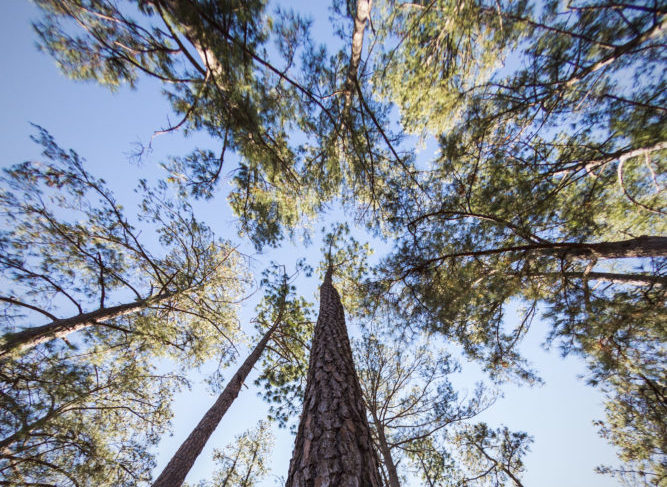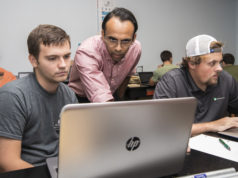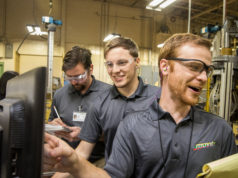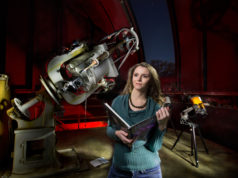How ‘Chainsaw Doug’ saved the day, and helped build one of the prettiest campuses in the state
— Joyce Kilmer
Some Francis Marion University (then College) maintenance workers needed a cleared area to park some machinery, or for some other utilitarian goal, and so, in the woods just off modern day Patriot Drive, more or less where the University Apartments now reside, they grabbed their chainsaw(s) and set to work removing enough timber to achieve their end.
The space cleared was not large, the number of trees taken not significant. But that did not matter to Dr. Doug Smith, FMU’s first president. If the brand new institution he was helping build out east of Florence was ever to amount to anything, if it was going to grow up to be a real college, by golly it would have to look like a real college. And in Smith’s mind that meant, among things, there would have to be trees. And that meant not only embarking on a serious campaign of planting trees, which Smith and company were already doing; it meant saving the ones in place, even if they were far off the campus’ then rather meager beaten paths.
So the offending parties and their supervisors were called onto the presidential carpet and the word went out: don’t touch Dr. Smith’s trees.
And while you’re at it – and this is where the saga gets a little hazy – put down that chainsaw. In fact, from this time forward, no one but Dr. Smith is allowed to crank a chainsaw on campus. Or, in another version, the only chainsaw allowed on campus is the one in the trunk of Dr. Smith’s car.
Smith, now 98 and several decades removed from his tree-saving days on campus, recalls the incident, if not the resulting edict, vividly.
“There was one occasion where some of the workforce needed a cleared off space, not very big, but they removed several trees to do it,” says Smith. “I don’t remember how many, but it was certainly enough to get my attention … And I remarked – maybe it was more than a remark – ‘anybody who works here, had better not cut anymore trees.’”
And the chainsaw ban?
Smith shrugs.
“I remember hearing that (the chainsaw story), about my car was the only one that could hold a chainsaw, and so forth, some time later,” he says. “There’s no telling how many versions there were. It made a good story. I don’t remember it exactly … but I do know this: we had no more trees cut down while I was here. That was the end of that.”
Well, not quite the end.
When Smith retired as president in 1983, the very first parting gift presented to him at a light-hearted farewell ceremony in (what is now) Chapman Auditorium was … a chainsaw.
Cotton and soybeans
The natural beauty of the campus is one of FMU’s most famous attributes today. The tree canopy, combined with numerous water features and masses of azaleas, camellias and other flowering shrubs native to the region, produces an strikingly appealing setting. There’s shade for the summer, bright foliage for fall and spring. Throughout, a peaceful majesty reigns, softening the necessary intrusions of steel and stone.
It looks like it’s been that way for a long time, and so, a first-time visitor to the Francis Marion University campus today can be excused for some confusion; for the common perception that a functional set of educational buildings were dropped, at some point, into the midst of an inviting forest populated by towering pines and graceful live oaks.
In fact, it was mostly a big ol’ field.
The Wallace family, which donated the land for both FMU and its predecessor, the Florence branch campus of the University of South Carolina, had farmed the campus lands, and hundreds of acres in every direction around it, for centuries. Brothers Walter and Joe Sallenger, university employees (and in Walter’s case, a FMU graduate), recall a sprawling collection of cultivated fields, grazing pastures and dirt roads, speckled with an assortment of out buildings — cabins, small barns, smokehouses and even one outhouse (a six-holer, erected in conjunction with an old school on the extreme south end of the property).
“There were a few trees, in low places you couldn’t farm and clustered around some buildings,” Walter Sallenger recalls, “but walking from my house to my grandma’s house, or some other place out here in the summer … whew! Not much shade.”
Adds Joe, “Where the soil was good, they farmed. And where it wasn’t there might be some trees. But for the most part it was a working farm.”
Indeed, the farming continued as school got underway.
Dr. Smith says cotton was still growing in the field in front of what would become the Rogers Library the first time he saw it. And Dr. Kay Belanger Lowrimore, a professor in today’s FMU School of Business who was a student in those early days, recalls thinking that it looked like “somebody had just pulled up the soybeans right before classes started.
“I mean, it was a big old field,” she says. “There wasn’t much here at all.”
There is something to be said for creating a brand new college on such a plain, feature-less tableau as that. Really, almost any layout can be considered, and the cost associated with clearance is almost nil. Run a bulldozer over it a couple of times and you’re done.
But from an aesthetic point of view academic buildings in a field leave something to be desired.
So, trees were always part of the FMU campus plan. The Wallaces were for that, too, says Joe Sallenger. They communicated their wishes that the trees — a few of them hundreds of years old — be saved. They never put any kind tree-cutting approvals in writing, preferring to leave that in the hands of “Chainsaw” Smith.
Trees: ‘It’s obvious’
Even before he took office Smith was busy planning for the orderly development of the campus. In the winter of 1969-70, a couple of FMU’s first trustees and representatives of two landscape firms – Gill and Wilkins of Florence and Unberto Innocenti-Richard K. Webel of New York gathered with the president in the kitchen of Smith’s resident in Salisbury, Md. to make plans. The discussion was all about long-term planning. Campus development was organized so as to encourage orderly growth and avoid the temptation of future deviations. For that reason, the first new building, after Stokes Hall (now Stokes Administration Building) was the Rogers Library.
Some balked at that idea – the two campus buildings were so far apart – but the concept allowed the campus to grow together.
There were few complaints regarding the strategy and tactics used to address campus aesthetics, which included an important decision to keep all the utilities underground (underground electrical lines were not common at that time) and a clear directive to turn the old farm into a place of academic beauty. Indeed, that idea that FMU’s campus would be pleasing to the eye was considered a core value.
In Quantum Leap, the definitive account of FMU’s founding years, author and trustees James A. Rodgers notes that, “Almost as strong as the desire that Francis Marion College become recognized as an institution of academic integrity was the sentiment that its campus be developed to reflect the natural beauty around it.” To that end, “hundreds” of trees and shrubs were planted as soon as the ground could be prepared.
“You’re going to have a flowers and trees on a campus. It’s obvious,” says Smith. “There was no question about that. The architect was very good and included lots of trees, shrubbery, right from the start. It was just something we were going to do.
“I know several of our trustees, some others who were involved, had seen the Furman campus (in Greenville, S.C.), which many people think is one of the prettiest anywhere. We wanted to come as close to that as possible while still keeping it in line with what’s natural to this region.
“We never strayed from that, even though it could be daunting at times, doing work like that that wouldn’t pay off for years,” says Smith. “But there were always a good feeling about that. As I told the board many times, ‘now look here, we’re just starting it. We’ve got to give them a little structure, a foundation, so there’s something to build on. Most of those there at the beginning understood that, although as I said it could be hard to see.”
Says Lowrimore Belanger, “They planted these trees but they were tiny little things, all held up by string to make sure they didn’t fall over. It’s hard to imagine, but those are the great big trees we have out here today.”
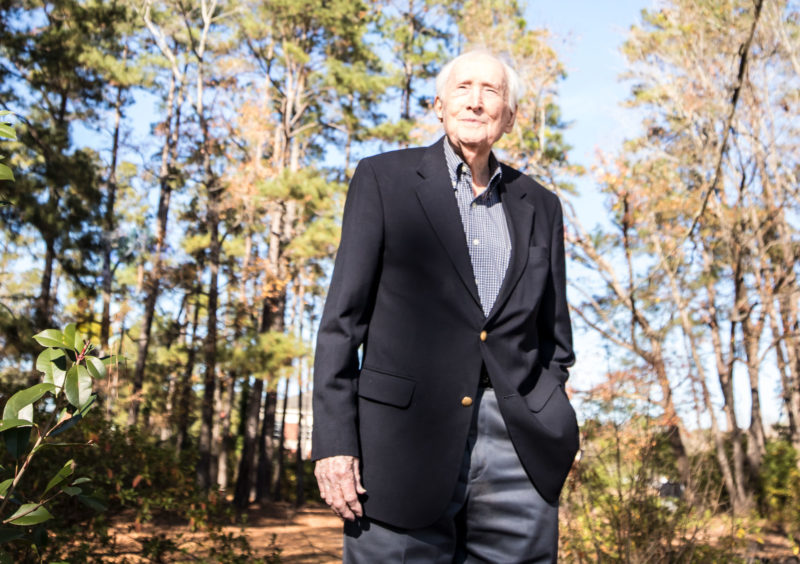
Sapsuckers, et al
When Frank Braddock took over as the head of outside maintenance – trees, landscaping, etc. – in 1990, some seven years after Smith’s retirement as president, he says it was still clear that trees on campus “were kind of sacred.
“That was my understanding,” says Braddock. “We’d all heard the stories about Dr. Smith. Nobody was cutting anything down, alive or dead, without an executive order. We were very, very careful.”
That care extended to both the selection of the plants and the tending of them. Braddock says. Although President Smith says FMU followed the plans laid out by its original landscape architects for years – “We felt like we’d paid good money for those ideas and that we ought to use them,” he says – eventually some updating was required. Well-known names in the field like Hugh Dargan lent their expertise to the design and concepts that shaped the university.
Plants selected were generally natives of the area, which meant that they not only blended well with the surrounding landscape but enjoyed vigorous growth as well. Counsel from the Biology Department was given heed and some plants were installed to attract birds and animals. Others, planted alongside windows, were selected because they had thorns or other features that could discourage unwanted intruders.
After the bulk of the trees and shrubs were planted, a succession of landscapers and maintenance men went to work keeping them alive. It wasn’t always easy. Storms, disease and assorted pests were/are a constant problem.
Braddock and his crews spent time battling powder post beetles in the tops of 70-foot tall trees and fighting off a gall wasp attack on the oaks lining Alumni Boulevard. On another occasion, an administrator called Braddock to find out what was wrong with a particular tree on campus. Braddock investigated and determined that it was the victim of the Yellow-Bellied Sapsucker, a type of woodpecker that can damage trees by “girding” the bark.
When Braddock explained the problem, the campus executive was incredulous.
“He didn’t think (the Yellow-Bellied Sapsucker) was a real thing,” said Braddock. “But it is. I typed up a report for him (the administrator) and everything.”
‘They’re so small!’
The process of building and maintaining continues.
As new buildings arise, new plants are added to the mix. Recent additions like Hanson Park, between the Stokes Administration Building and Wallace House, add to the effect. The maturation of other areas validates the original vision, as does –surprisingly – the damage wreaked by storms.
Hurricane Matthew, which hit the Pee Dee a sharp blow in the fall of 2016, downed more than 30 large trees on the FMU campus. Crews moved quickly to clear the downed timber and clean up debris. When they were done, what was remarkable was the arboreal absences really weren’t that noticeable. There are that many trees on campus today.
Some of this is just the passage of time in spaces that were partly wooded in 1970. The area surrounding the pond behind the Lee Nursing Building (the pond, dug by the railroad when it was looking for fill dirt, was enlarged during the initial campus development. That caused some student uproar when the work began because they thought it was being filled in — it wasn’t. Construction just added two “fingers” to the old rectangle “design” produced by the railroad.) is now covered with large pines and other mature trees. Old-timers remember being able to stand between the pond and Highway 327 and see Rogers Library. That’s no longer possible. And the shaded pathways leading to the residential areas of campus, spaces carved out of the most heavily treed part of the original acreage, are now pleasing natural arbors.
A lot of it is the result of a well-managed plan. The mass clusters of azaleas that light campus each spring are no accident. And it was always intended that the oaks lining Alumni Drive would grow together overhead and form a leafy arch above a main campus artery.
Those trees are just about there now.
Doug Smith says that might come as a surprise – a pleasant one – to some doubters from days gone by.
“I remember one time shortly after we had planted all those oaks (lining Alumni Drive),” he says. “The wife of one of our board members looked at all those little trees – they were about two inches in diameter, maybe less – and said to me, ‘those sure are small trees.’ I think she was kind of asking a question like, ‘do you think they’ll ever be large?’ Or maybe it was, ‘do you think you’ll ever see them amount to anything?’
“Well, we have, we have,” says Smith. “It’s just beautiful.”


